Demasani Cichlids are one of the most underappreciated and little-known mini mbunas in the hobby. These lovely and small fish were just discovered and described in 1994. These gorgeous Malawi fish grow to be around 2.5 to 3 inches long. In an aquarium, they can be mixed with the other Mbunas for a beautiful display of color. Don’t forget the fact that these fish have a variety of characteristics. Therefore, they could be dangerous in the hands of unskilled people.
In honor of Laif Demason, the cichlid Demasoni was named after him. He was a popular fishkeeper who is credited with bringing this rare cichlid species to the West. Demasonis are found in Lake Malawi’s Pombo Rocks and Ndumbi Reef regions. It takes moderate to complicated care for these species. It is highly aggressive. Hence, this zebra-type cichlid is most suitable for intermediate to expert fishkeepers.
Demasoni Cichlids are classified as ‘threatened’ by the IUCN. However, since their launch in 1994, they’ve been widely accessible in the US and Europe at a reasonable cost.
So why should you get Demasoni Cichlids in the first place? They’re tiny, and they have beautiful colors. They’ll also look great with your Mbuna tank.
Table of Contents
Demasoni Cichlid Care
Demasoni cichlids are moderately easy to care for, because they are semi-aggressive fish that are incompatible with other fish species. They require a 40-gallon tank and a moderate water flow of 10 to 18 dGH. They are omnivores, but its best to feed them a vegetarian diet.
Demasoni Cichlid Quick Stats
| Information Chart | Demasani Cichlids |
| Scientific Name | Pseudotropheus Demasoni |
| Family | Cichlidae |
| Care Level | Moderate |
| Temperament | Semi-aggressive |
| Color | Dark blue with black vertical stripes with alternating lighter stripes of light blue to white |
| Lifespan | Up to 10 years |
| Size | 2 1/2 to 3 inches |
| Diet | Omnivore |
| Minimum Tank Size | 40 gallons |
| Temperature | 75-82°F |
| Water Conditions | Moderate flow, 10-18 dGH |
| Tank Mate Compatibility | Incompatible with other species |
Demasoni Cichlid Appearance
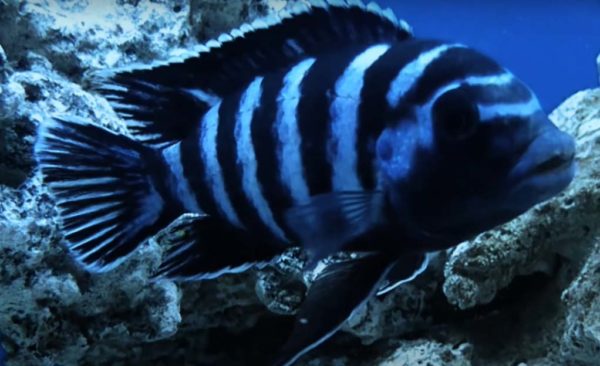
Demasonis cichlids are little cichlids that grow to be 2.5 to 3 inches long. They feature the classic Mbuna body form with an elongated ‘torpedo’ shape.
The body is decorated with alternate vertical stripes in a variety of blues, including black, dark blue, and light blue. It begins with a dark stripe just beyond the gill cover. It finishes with another subdued dark stripe at the tail fin’s base. There’s usually a mix of six dark and five-light lines. Three pale blue stripes alternate with two dark blue stripes on the skull. Between each pair of eyes is one of the black lines. The other runs over the forehead and merges with the very first dark bar under the gill cover.
There is a light blue tint on the chin. The dorsal fin stripes are angled backward. The lighter ones are slightly narrower than, the darker ones. In addition, the tail fin features very fine dark and soft blue horizontal lines. It has a bright blue border that is highlighted with a deeper blue tint.
Spiny rays line their dorsal, anterior, and pectoral fins to defend them from predators. The frontal region of these fins has a smooth texture that aids in effortless swimming.
In addition to their conventional teeth, Demasonis have fully developed pair of pharyngeal teeth in their throat. Finally, unlike most other fish, they only have one pair of nostrils on each side.
Demasoni Cichlids – Lifespan
The typical lifespan of a Demasoni Cichlid is up to over 10 years. In comparison to other fish, the Demasoni Cichlid has a long lifespan. Under ideal conditions, the lifespan of a Demasoni Cichlid can be longer than ten years. However, it is relatively uncommon for a Demasoni Cichlid to die instantly after being placed in an aquarium. There may be a connection between shipping stress or different water parameters between the home tank and store display water. Hence, if you provide your Demasoni Cichlid with a healthy diet, they can live a long and happy life.
Challenges That You May Face In Keeping Demasoni Cichlid
It’s an excellent fish for intermediate and advanced Cichlid keepers. It’s a ferocious Cichlid. It isn’t a neighborhood tank species that can be kept alongside fish other than Cichlids, despite its smaller size than other Mbuna.
Aquarists must be eager to do regular water changes. They must give suitable tank mates. If the tank is not kept clean, it is susceptible to Malawi bloat as well as the common ailments that affect all freshwater fish. It can quickly adjust to ready meals. They breed quickly. The youngsters are very easy to raise in the right environment.
How Many Demasoni Cichlids Should You Keep Together?
To disperse antagonistic behavior, keep over 12 Demasoni Cichlids together. These fish dwell in enormous swarms in the wild. However, in ca In captivity, the goal of maintaining a large school is to scatter and disperse out the bullying that the dominant male propagates on others. In this manner, the hostility won’t be directed just at a few fish. If you have a smallish school of Demasoni, the dominant male will intimidate all of the fish until he is left alone.
For every male, there should be at least 3 to 4 females. Polygamous relationships are common among these fish. In this case, a male mates with multiple females. Maintaining a more enormous female population will result in much more fry later on.
Demasoni Cichlids – Sexual Dimorphism
Adult male Demasoni Cichlids are significantly bigger than female Demasoni Cichlids. They’re also darker in color. They have an egg patch on their anal fins. The females do not have this. Finally, they have longer and pointier dorsal and anal fins than females. They are shorter and rounder.
On the other hand, male and female Demasoni Cichlids look nearly identical as youngsters. As a result, unless you turn to vent, sexing them might be difficult.
Demasoni Cichlid – Feeding
Cichlids of the Demasoni genus are omnivores with a strong preference for herbivorous diets. Because of their diminutive stature, they may have limited hunting abilities. They eat aufwuchs and other small invertebrates that they stumble upon in the wild. Supplementing their diet with vegetables helps maintain their intestines clear of sickness and difficulties. An occasional indulgence of live meals like smaller fish and shrimp can be beneficial. Do not give them a single large feeding in one go. It is preferable to provide multiple little meals throughout the day to assist preserve water quality. Demasoni Cichlids are unable to consume mammalian flesh, such as the beef heart. Feeding them this will result in illnesses and death. You can give them the following food:
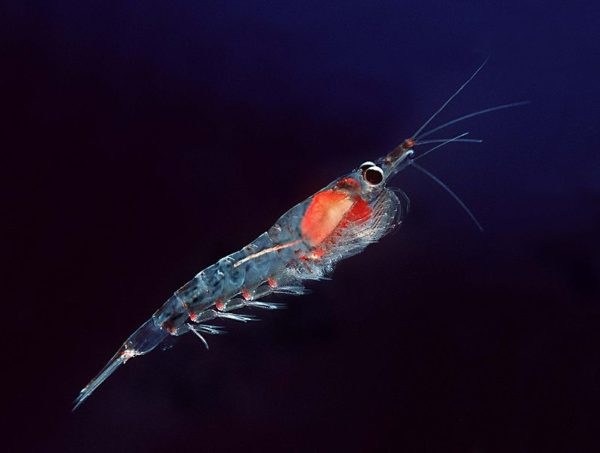
- Zooplankton
- Blanched vegetable
- Brine shrimp
- Blackworms
- Cichlid flake/pellets
- Spirulina algae
- Aufwuchs
- Small crustaceans
- Mites
- Snails
- Insect larvae
- Nymphs
- Dried seaweed
Although there are a lot of meaty dishes on this list, it’s recommended to stick to a vegetarian diet. An omnipurpose cichlid formula can be used to enhance the diet. Fiber-rich foods will maintain the intestines healthy. Spirulina-rich foods will improve the color of the fish. Your Demasonis will, of course, profit from the addition of vitamins and supplements to their diet. Your Damasonis shouldn’t be kept with cichlids that require to eat any kind of animal flesh since they can’t digest it. This has the potential to be quite dangerous. When it comes to feeding frequency, provide 2-3 short meals each day rather than one large meal. Give them a portion that they can finish in under three minutes. These techniques will assist in keeping the water cleaner for a more extended period of time. Adults should fast once in a while to keep their metabolism in check.
Demasoni Cichlid – Natural Habitat
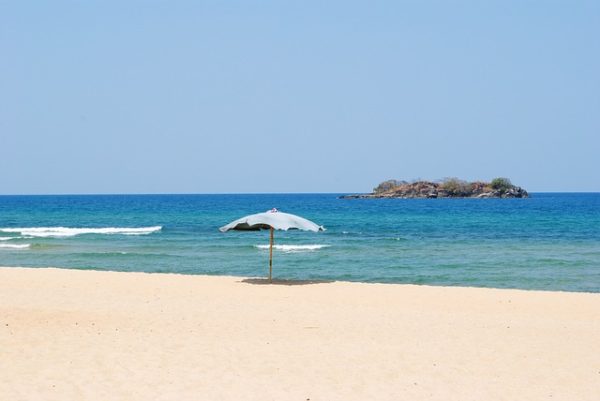
Demasoni Cichlids have a limited range, despite being indigenous to the enormous Lake Malawi. Pombo rocks and Ndumi reef are the only places where they may be found. They frequently live in big flocks in rocky areas. The mineral concentration of the rivers that feed into this lake is considerable. Similarly, the composition of the water does not alter significantly. It’s hard to replicate all of the same parameters in the tank. However, it’s critical to keep these things in mind when setting up your Demasoni Cichlid tank.
The Demasoni Cichlid may be observed in moderate schools in its native habitat. They are quite active and competitive. Their numbers are regulated in an aquarium. Hence, they are usually properly fed. As a result of these factors, this little Mbuna has a propensity to grow somewhat larger in a household setting.
Minimum Tank Size For Demasoni Cichlids,
Demasoni Cichlids, require a minimum tank capacity of 40 gallons for one fish. However, because you’ll have to keep a school of these fish, you will need a tank capacity of 100 gallons or more. The tank should have a broad and lofty profile. It needs to be at least 90cm/36′′ long. This is to guarantee that there is enough space for swimming, decorating, and breeding.
Suitable Substrate for Demasoni Cichlids
Sand is the ideal substrate for Demasonis. You can also use smashed coral. You can also have a combination of gravel and smashed coral. You can use sand or substrate used for saltwater tanks in maintaining higher pH levels. This is because they break down quicker than sand. However, a greater ph level in the tank also indicates a greater ammonia level. So, don’t forget to replace the water frequently.
Decoration for Demasoni Cichlids
Demasoni cichlids requires aquariums with several rock features. Since these fish are incredibly inquisitive and hardy, this is the case. As a result, strategically placing decorations in the tank may assist in reducing boredom and antagonism.
You may arrange the rock heaps to construct a variety of pathways and caverns. This will help the fish in carving out their own individual territories. This is advantageous to females and docile males. Distractions such as shifting pebbles here and there can also help an angry man healthily channel his fury.
However, make sure that all decorations are securely fastened to the substrate such that the fish does not knock them over.
Tank Set-Up for Demasoni Cichlids
The water in a Demasoni Cichlid tank should be alkaline and heavily mineralized. It should be equipped with a well-established filtering system. To prevent Malawi bloat, 30 percent weekly water changes are required. When putting together a tank for a bunch of Demasoni Cichlids, choose a tank size that is adequate for the number of Cichlids you plan to have. A sand/gravel mix should be used as the substrate, and moderate illumination should be used. Average water movement is also recommended. This small Mbuna should be able to discover and hide in a range of rocks and hiding spots. Moving pebbles about in the tank on a regular basis can also help reduce male hostility.
Water Parameters For Demasoni Cichlids
Lake Malawi’s water characteristics, like those of any other lake, are incredibly constant. Demasonis, on the other hand, aren’t fond of abrupt changes in their surroundings. Each week, you should replace around 30% of the water. If the tank is overcrowded, strive for a weekly water change of 50%. Similarly, the water in the lake is exceptionally mineralized and alkaline. As a result, you may employ salt as a stabilizing agent to raise the water’s carbonate hardness. These fish can tolerate a certain amount of salt. Therefore, they may be housed in somewhat brackish water. These fish, in particular, can withstand salinity levels at about 10% of a typical saltwater tank. Demasonis don’t create a lot of bioload because of their modest size. You will, however, need to purchase in a reliable filtering system. We recommend purchasing either two external filters or a single strong filter.
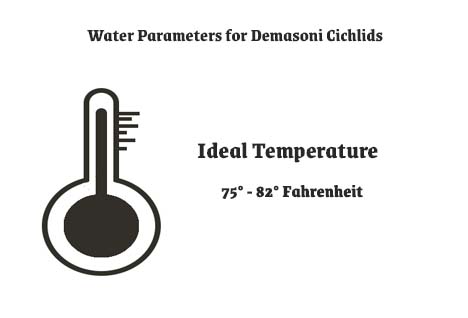
The tank water temperature should be kept between 75°F and 82°F. The overall hardness should be between 10GH and 18GH while caring for a Demasoni Cichlid. When caring for Demasoni Cichlids, an intermediate degree of aquarist experience is suggested. This is due to the fact that the habitat that these fish require is relatively hard to maintain. These fish originate in Africa. As a result, they are accustomed to higher water in temperature and have a hardness range of 10 to 18 GH. While salt does not occur naturally in their habitat, they have a low tolerance for it. Salt levels must be maintained beneath 10% with a gravity of about less than 1.0002 if you’re using it.
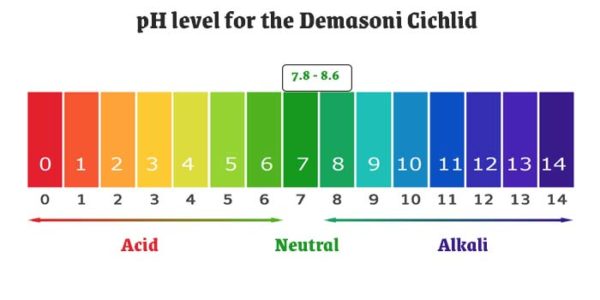
In a Demasoni Cichlid environment, the pH of the water is usually around 7.8 and 8.6. This is quite alkaline. Cichlids of the Demasoni species love to swim in the middle of the tank. As a result, they thrive in water with a pH of 7.8 to 8.6. This solution is very alkaline. The bulk of Malawi Cichlids will suffer health issues under unmonitored or ignored water conditions. As a result, maintaining a constant pH level is crucial. Any sudden changes in pH can be hazardous, resulting in illness or death. This is because these fish have a really restricted pH tolerance range. While there are many options available, you may try adding peat moss in the filter to decrease the pH and a tiny bit of baking soda to boost the pH.
Demasoni Cichlids – Tankmates
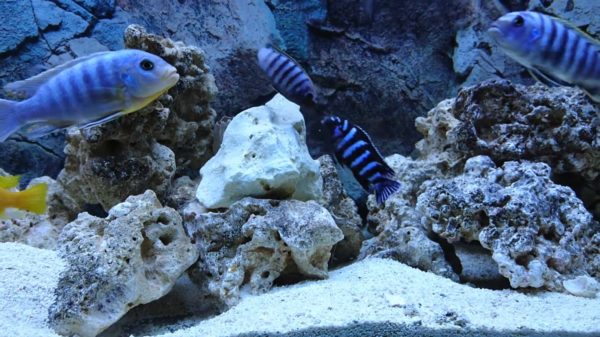
Other yellow Mbuna or a yellow Labidochromis Caeruleus species are common Demasoni Cichlid tankmates. A yellow variety of Electric Yellow Labidochromis Caeruleus, the Red Zebra Maylandia Estherae, and the Cobalt Zebra Maylandia Callainos are all good tankmates. Their tankmates should not have the same colors or bars as your Demasoni Cichlid. Tankmates should also have comparable tank water needs and also a similar disposition. Similar-colored species like the Dogtooth Cichlid and Kenyi Cichlid are instances of tankmates that the Demasoni Cichlid does not get along with.
Avoid big aggressive types of fish while hunting for fish to live under the same roof as the Demasoni Cichlid. Melanochromis and Labeotropheus are among the most common Melanochromis and Labeotropheus species. Choose more Cichlids that are similar in nature but have a distinct color and design. Demasoni Cichlids are aggressive. Therefore, keep them in a group of approximately 12 to help diffuse aggressive behavior. A school of 12 or maybe more Demasoni Cichlids aids in the dispersal of aggressive male behavior. However, if you just have one male, the majority of the people will perish. As a result, the male-to-female ratio might fluctuate. Cichlids of the Demasoni genus are similarly hostile against other fish. As a result, mixing them with more docile species might be difficult.Oscars and Demasoni Cichlid: Oscars and Demasoni Cichlids are not tankmates. This is because they have separate tank needs. Demasoni Cichlid males are aggressive. The Oscar is a gentle creature. As a result, mixing them in the same tank is problematic. The Oscar is likely to be bullied to death by the Cichlid. These fish also have pretty distinct water needs. If you put them in the same tank, one of them is susceptible to succumb to health problems caused by the environment. Yellow Labs and Demasoni Cichlid: Yellow Labs and Demasoni Cichlids make an excellent tank combo and can be visually appealing. These Yellow Labs consume equal amounts of water and have a similar disposition. As a result, they make excellent tankmates for Demasoni Cichlids. The brilliant yellow of the Demasoni Cichlids, along with their stunning blue tones, creates a really pleasing visual experience.
Peacock Cichlid and Demasoni Cichlid: A tank with Demasoni Cichlids and Peacock Cichlids can be a good match. This is only possible if you have adequate room and understand how to feed your fish with precision. The Peacock Cichlid may not be as violent as the Demasoni Cichlid. Hence, they are not commonly maintained together as tankmates. They might get along if you’re an accomplished aquarist who knows how to target feed. They must have plenty of room in a massive tank with lots of rocks and hiding places, but it’s not ideal.
Demasoni Cichlid and Angelfish: Because of their temperamental differences, angelfish and Demasoni Cichlids might not always be good tank mates. Angelfish have a calm demeanor. In a habitat with your Demasoni Cichlid, this puts them at risk of being harassed, pursued, and agitated. This combo isn’t a good idea. The Angelfish has sensitive long-flowing fins that the dominant Mbuna can seriously harm.
Breeding Demasoni Cichlids
Breeding of Demasoni cichlids are quite similar to breeding other genus fish. Mouthbrooders, polygamists, and matriarchal families are all characteristics of this fish. If you want to breed them, you need to set up a dedicated breeding tank to maximize the fry’s chances of survival.
When the male is ready to mate, he will change color to a deeper hue. He’ll also grow enraged at the presence of other males in the tank. He has the ability to bully a perceived competitor to death. He will also strike out at bottom dwellers in his search for a good mating site.
If you plan to breed them, don’t forget to include flat rocks in the tank that can be used as egg-laying sites. Often, spawning is triggered by a high-protein diet and frequent water changes. After locating a good mating location, the male will attempt to entice the probable female to it. The male will then shake and whirl around the female in order to court her. It will also bite and harass on this occasion. After that, the willing female would go to the egg-laying site and lay her eggs. Depending on the age and condition of the female, she may lay anywhere from 5 to 15 eggs.
If you plan to breed them, don’t forget to include flat rocks in the tank that can be used as egg-laying sites. Often, spawning is triggered by a high-protein diet and frequent water changes. After locating a good mating location, the male will attempt to entice the probable female to it. The male will then shake and whirl around the female in order to court her. It will also bite and harass on this occasion. After that, the willing female would go to the egg-laying site and lay her eggs. Depending on the age and condition of the female, she may lay anywhere from 5 to 15 eggs.
Ensure you channel the utmost delicacy when transporting the nesting fish to the new tank. When agitated, these cichlids are prone to spit up their eggs early. It’s also a good idea to move the shrimp at the last minute. If the female cichlid is missing from the main tank for an extended period of time, she will abandon her habitat and move down the hierarchy pyramid.
Top Equipment For Demasoni Cichlids
Despite their tiny size, these fish require some attention and maintenance. The larger the tank, the easier it is to keep hostility in check. Similarly, the filtration and heater systems should be sound and durable. This is because they do not tolerate filthy water or unexpected temperature fluctuations well.
There are several types of equipment in the market available for your Demasoni Cichlids. These are our top picks:
- 150-Gallon Starfire Glass Aquarium
- Cascade Canister Filter For Up To 200 Gallons
- Hygger 800 Watts Submersible Heater
- JIH Aquarium Fish Tank Plastic Plants and Cave Rock Decorations
Conclusion
So that’s all we have to say about the Demasoni Cichlids. We’ve included the information you need to take care of these fearsome little fish. Their character is prominent, but the size is small. Even the tiniest fry may be aggressive. To prevent sad outcomes, you’ll need to get some things done right, such as a large aquarium and appropriate tankmates.
No related posts.

